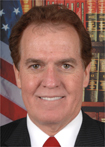Momentum Builds For National Right to Work Act
(Source: January 2011 NRTWC Newsletter)
Forced-Dues Clauses in Federal Labor Statutes Ripe For Repeal
There appears to be light at the end of the forced-unionism tunnel for America's workers.
In last year's elections, disgusted voters repudiated the Big Labor agenda. Now Right to Work advocates are calling on the incoming Republican U.S. House leadership to allow hearings and a vote on national Right to Work legislation some time during the 2011-2012 Congress.
Although Right to Work measures have repeatedly been introduced over the years, House leaders in both parties have thwarted efforts to hold roll-call votes on legislation striking out the provisions in federal law that force millions of workers from coast to coast to pay union dues just to keep their jobs.
"Naturally, Big Labor House Democrats don't want to cast public votes to force American workers to continue to subsidize their campaigns with their union dues and fees," observed Greg Mourad, legislative director for the National Right to Work Committee.
"What's really strange is that, in the past, GOP speakers have been willing to let union-label Democrat politicians off the hook. But Right to Work supporters are already mobilizing to bring about a different outcome in the 112th Congress."
Forced Dues Enshrined In Federal Labor Law
The National Labor Relations Act (NLRA), which Congress first adopted in 1935 and has since only modified, not fundamentally changed, actually contains specific language protecting employee rights to join or refrain from joining a union.
But it's just a cruel joke. Why? Congress gutted its pious proclamations of worker freedom with "exceptions" such as the one tacked on to NLRA Section 7. Section 7's conclusion has trampled workers' freedom for three-quarters of a century, and is one of the most cynical exercises in legislative deception on record.







